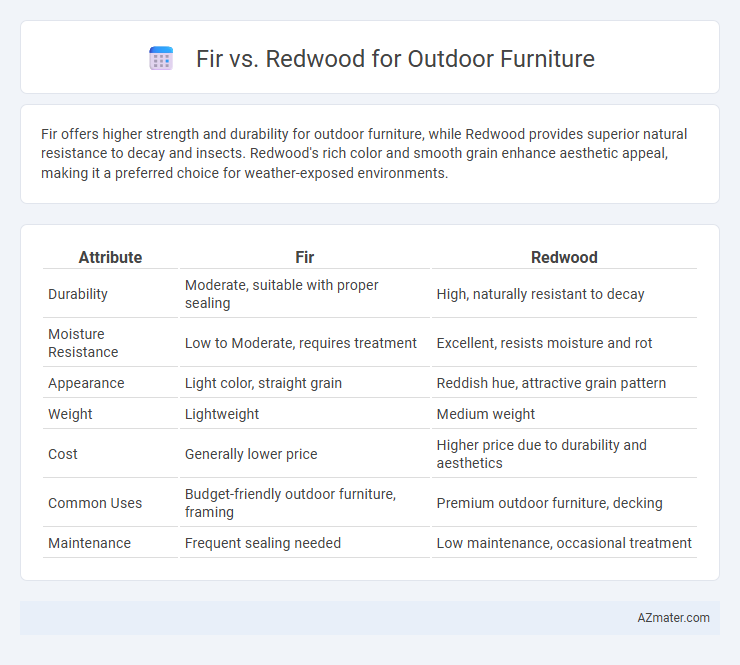Fir offers higher strength and durability for outdoor furniture, while Redwood provides superior natural resistance to decay and insects. Redwood's rich color and smooth grain enhance aesthetic appeal, making it a preferred choice for weather-exposed environments.
Table of Comparison
| Attribute | Fir | Redwood |
|---|---|---|
| Durability | Moderate, suitable with proper sealing | High, naturally resistant to decay |
| Moisture Resistance | Low to Moderate, requires treatment | Excellent, resists moisture and rot |
| Appearance | Light color, straight grain | Reddish hue, attractive grain pattern |
| Weight | Lightweight | Medium weight |
| Cost | Generally lower price | Higher price due to durability and aesthetics |
| Common Uses | Budget-friendly outdoor furniture, framing | Premium outdoor furniture, decking |
| Maintenance | Frequent sealing needed | Low maintenance, occasional treatment |
Introduction to Fir and Redwood for Outdoor Furniture
Fir wood offers a strong, durable option for outdoor furniture, known for its straight grain and resistance to warping. Redwood, prized for its natural resistance to decay and insects, provides a rich, reddish hue that enhances the aesthetic appeal of outdoor pieces. Both woods deliver distinct benefits in weather durability and visual warmth, making them popular choices for long-lasting outdoor furniture.
Key Differences Between Fir and Redwood
Fir is a strong, affordable softwood commonly used in outdoor furniture, known for its light color and smooth grain but requires proper sealing to resist moisture and decay. Redwood, valued for its natural resistance to rot and insects, offers a rich reddish hue and superior durability, making it ideal for long-lasting outdoor pieces without heavy maintenance. While fir provides budget-friendly options, redwood's higher cost aligns with enhanced longevity and premium aesthetic appeal in outdoor environments.
Durability: Fir vs Redwood in Outdoor Settings
Fir wood offers moderate durability in outdoor furniture, requiring regular sealing to prevent moisture damage and insect infestation, making it less ideal for long-term outdoor exposure. Redwood boasts superior natural resistance to decay, moisture, and pests due to its high tannin content, providing exceptional durability and longevity in outdoor settings. Between Fir and Redwood, Redwood is the preferred choice for outdoor furniture where durability and weather resistance are critical factors.
Resistance to Weather and Decay
Redwood offers superior resistance to weather and decay compared to fir, thanks to its natural oils and dense grain structure that repel moisture and inhibit fungal growth. Fir tends to absorb water more readily, making it prone to swelling, warping, and faster deterioration when exposed to outdoor elements. Choosing redwood for outdoor furniture ensures longer-lasting durability with minimal maintenance in harsh weather conditions.
Appearance and Grain Patterns
Fir wood features a pale, creamy color with a straight, uniform grain pattern that offers a clean and classic look for outdoor furniture. Redwood stands out with its rich reddish-brown hues and pronounced, elegant grain streaks, providing a warm and luxurious aesthetic. Both woods showcase distinct natural beauty, but redwood's deeper color and bold grain make it a more striking choice for visually impactful outdoor pieces.
Maintenance Requirements for Fir and Redwood
Fir outdoor furniture requires regular sealing or staining to protect against moisture and UV damage, as its softer wood is prone to warping and cracking without proper care. Redwood naturally contains tannins and oils that resist decay and insect damage, significantly reducing maintenance frequency, usually limited to occasional cleaning and reapplying sealant every few years. Both woods benefit from proper sealing, but redwood's inherent durability makes it a lower-maintenance option for outdoor furniture.
Environmental Sustainability and Sourcing
Fir and redwood differ significantly in environmental sustainability and sourcing for outdoor furniture. Fir is a fast-growing softwood often sourced from sustainably managed forests in North America, offering a lower carbon footprint due to rapid regrowth. Redwood, primarily harvested from old-growth forests in California, faces challenges related to over-harvesting and habitat loss, but responsibly sourced redwood from certified suppliers ensures long-term forest preservation and durability in outdoor settings.
Cost Comparison: Fir vs Redwood
Fir wood typically costs less than redwood, making it a more budget-friendly option for outdoor furniture projects. Redwood, known for its natural resistance to decay and insects, commands a higher price but offers greater durability and requires less maintenance over time. Considering the initial investment and long-term value, fir is suitable for cost-conscious buyers, while redwood appeals to those prioritizing longevity and aesthetics.
Best Uses for Fir and Redwood in Outdoor Furniture
Fir is ideal for outdoor furniture that requires strength and affordability, making it suitable for structural components like benches and tables exposed to moderate weather. Redwood offers natural resistance to decay and insects, making it perfect for outdoor pieces like Adirondack chairs or garden benches where durability and aesthetic grain are key. Both woods perform well outdoors, but Redwood excels in longevity and appearance, while Fir provides a cost-effective option with adequate durability when properly treated.
Final Recommendations: Choosing the Right Wood
Fir offers affordability and strength, making it suitable for budget-conscious outdoor furniture projects with moderate exposure to elements. Redwood provides superior durability, natural resistance to decay, and rich color, ideal for long-lasting furniture in harsh outdoor environments. Opt for fir when cost-effectiveness and strength are priorities, while redwood is best for premium outdoor pieces requiring high weather resistance and aesthetic appeal.

Infographic: Fir vs Redwood for Outdoor Furniture
 azmater.com
azmater.com